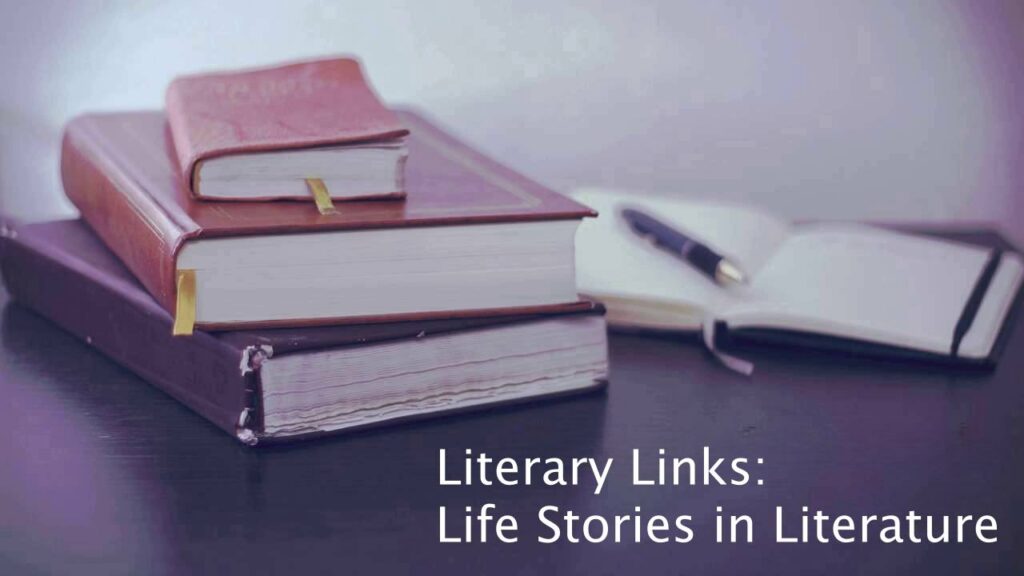Life Stories in Literature
Themes
identity
family
we are what we remember
inside vs. outside stories
imposters
hidden identities & secrets
trauma
creating/controlling one’s own narrative
cultural appropriation
alternate life options
alternative selves
turning points/life decisions
when/how lives intersect
multiple points of view
rewriting history
change your story, change your life
The Real Science Behind Dark Matter Will Melt Your Gray Matter
The multiverse is a compelling image for Life Stories in Literature because it offers the possibilities of multiple lives. The first novel I remember that used this concept is Dark Matter by Blake Crouch.
The novel is now being made into a series for Apple TV+ (scheduled to begin on May 8), and this article suggests that the series will hit the scientific aspects of the story much harder than the novel does. Here writer Anthony Breznican talks with author Blake Crouch and some of the series actors about the scientific theories behind the story and how the production features those concepts.
How Haunting Is a Perfect Metaphor for PTSD
“When someone has PTSD, the ghosts follow them everywhere they go…”
From one metaphor to another. Tyffany D. Neiheiser explains why ghosts and haunted houses are such a powerful metaphor:
Most of the lore on ghosts say that they stick around when they have unfinished business. That they can only be put to rest when they’ve resolved whatever it is that they needed to.
And that’s a perfect description of trauma. It’s unfinished business. It’s in the past, but it hasn’t been resolved. It hasn’t been healed, which makes it a challenge to move on.
Trials of the Witchy Women
“Across seven centuries, women have been accused of witchcraft—but what that means often differs wildly, revealing the anxieties of each particular society.”
“Marion Gibson, a professor of Renaissance and magical literature at the University of Exeter, has now written eight books on the subject of witches . . . Her eighth book, “Witchcraft: A History in Thirteen Trials” (Scribner), traverses seven centuries and several continents,” writes Rivka Galchen in this piece for the New Yorker.
Like Gibson, Galchen here focuses not just on the accused, but on the trials themselves. She examines these trials to figure out how the defendants had violated the norms of their societies. It is possible to “glimpse the fears of the persecutors in the confessions they forced out of the accused,” she writes. By 1735, science had progressed enough to recognize that people do not have magical powers. England’s Witchcraft Act of 1735 “precipitated a shift from prosecuting people as witches to prosecuting people who presented themselves as witches. . . . Often enough, this meant putting the same sorts of people—women making money as healers or diviners, or colonized people whose local belief systems were frightening to the colonizers—on trial.”
Galchen’s analysis suggests the relationship between individuals and society. The prevailing culture passes laws and creates an ethos that sets up the notions of proper, acceptable behavior; people who challenge those notions are singled out and punished for their crime or their sin of nonconformity. The definitions of proper behavior and the punishments for nonconformity change with the times, but this process always works the same way.
The Twins Obsession
“From Romulus and Remus to Mary-Kate and Ashley, multiples loom large in our cultural and historical imaginations.”
Parul Sehgal focuses on the book How to Be Multiple: The Philosophy of Twins by Helena de Bres “to examine how multiples complicate our notions of personhood, attachment, and agency”:
Twins have been critical to our understanding of ourselves, she [Helena de Bres] argues; they are present in the founding myths of great cities. Romulus and Remus gave us Rome. The twins of the Hindu epic the Ramayana, Lava and Kusha, established Lahore and Kasur. Twins have been worshipped, killed at birth, paraded as curiosities, pricked and probed and experimented on. They have been treated as subhuman and superhuman, and seen to personify every possible duality: collaboration and bitter competition, the purest as well as the most morbidly enmeshed forms of love. And they continue to unsettle our notions about where bodies end and begin, about whether personalities, even fates, are forged or found.
‘Like a film in my mind’: hyperphantasia and the quest to understand vivid imaginations
“Research that aims to explain why some people experience intense visual imagery could lead to a better understanding of creativity and some mental disorders”
David Robson discusses hyperphantasia, the ability to imagine objects and scenes intensely and in great detail. “This once neglected form of neurodiversity is now a topic of scientific study, which could lead to insights into everything from creative inspiration to mental illnesses such as post-traumatic stress disorder and psychosis.”
Does It Seem Like the End Times Are Here? These Novels Know Better.
“What can fiction tell us about the apocalypse? Ayana Mathis finds unexpected hope in novels of crisis by Ling Ma, Jenny Offill and Jesmyn Ward.”
Ayana Mathis discusses three novels that, she says, “suggest new ways of seeing: a shift to deeper present-time awareness, even wonder, as the times grow ever more dire.”
The novels she looks at are Severance (2018) by Ling Ma, Weather (2020) by Jenny Offill, and Salvage the Bones (2011) by Jesmyn Ward.
Making the moral of the story stick − a media psychologist explains the research behind ‘Sesame Street,’ ‘Arthur’ and other children’s TV
Drew Cingel, an associate professor of communication at the University of California, Davis, studies “how to design media to support children’s learning, particularly in moral development.” In this article he reports on work done with three of his Ph.D. candidates, including efforts on “messages notoriously difficult to teach to young children, including lessons about death, divorce and racism.”
The article includes some advice on how “[p]arents and other adults can help children learn from media by watching alongside them and answering their questions.”
Power over Spice Is Power over All: Extractivism and Indigenous Knowledge in Frank Herbert’s “Dune”
I now live in Tacoma, Washington, the hometown of Frank Herbert, author of Dune. In this article Devin Griffiths, an associate professor of English and comparative literature at the University of Southern California, explains that Herbert discovered the setting for his famous novel when he visited the sand dunes of the coastal town of Florence, Oregon, with local naturalist Wilbur Ternyik in 1957.
This story explains the name of the park that the Metropolitan Parks Department recently opened to honor the novelist:

© 2024 by Mary Daniels Brown

